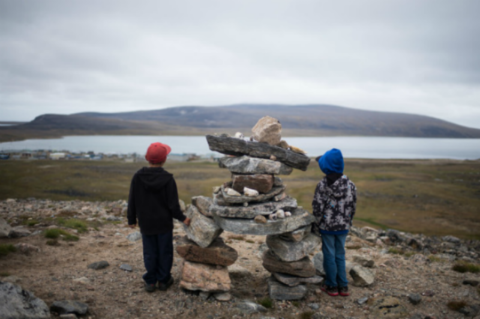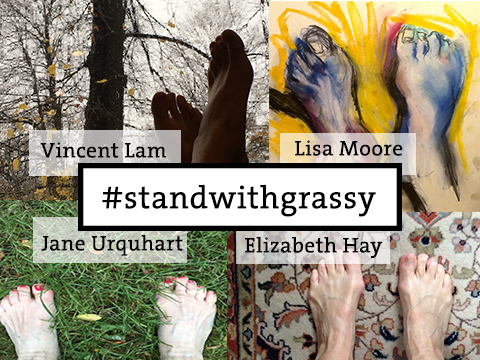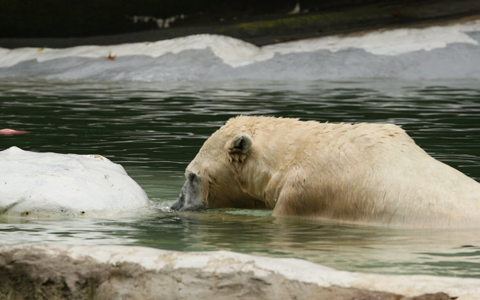David Suzuki's Blog, page 23
November 24, 2016
D-Day for Indigenous rights at the Supreme Court of Canada

(Credit: Greenpeace)
On November 30 the Supreme Court of Canada will hear two cases regarding destructive activities carried out by the National Energy Board and oil companies in or around the traditional territories of Clyde River Inuit and Chippewas of the Thames First Nation. These cases have many aspects in common, hence the decision to hear them at the same time.
At the core of the cases is the Crown's constitutional duty to consult Indigenous peoples on resource development projects within their territories. For the past two years, the community of Clyde River has been fighting to overturn a 2014 NEB decision that allows a group of oil exploration companies to conduct seismic testing in Baffin Bay and Davis Strait. Clyde River argues that the NEB did not sufficiently consult with Inuit on seismic testing projects. The case also raises questions about the legitimacy of the NEB to represent the Crown when consulting with Indigenous peoples.
Besides threatening wildlife and compromising the traditional hunt essential to Inuit survival in a region where food security is a chronic problem, the approval of seismic exploration against the will of Baffin Island Inuit is a clear violation of their rights under international law set out by the United Nations Declaration on the Rights of Indigenous Peoples.
Similarly, Chippewas of the Thames First Nation challenged the NEBs approval of the reversal of Enbridge's Line 9 pipeline between Sarnia and Montreal and deplore the lack of consultation with the community about this major pipeline passing where an oil spill could devastate the land and water.
The upcoming Supreme Court decision on these cases could be a landmark judgment and create jurisprudence that will reshape the future of resource development projects in Indigenous territories throughout the country. It will also clarify the NEB's role in consultations with Indigenous peoples, and the limit of its prerogatives to represent the Crown.
In this defining moment in the history of Indigenous rights in Canada, the David Suzuki Foundation reasserts:
We support Indigenous claims to be thoroughly consulted about development projects that threaten their way of life and culture, as is their right under Canada's constitution and international law. We also endorse the requirement to obtain their explicit consent for resource extraction projects proposed in their traditional territories.
Chippewas of the Thames First Nation and Clyde River Inuit are making an historic effort to defend their land and water from the impacts of fossil fuel development. By doing so, they are showing solidarity with all people in Canada concerned about climate change and Indigenous rights. We will stand in solidarity with them and all Indigenous peoples for their right to thrive in a healthy environment.
This is an opportunity for all people in Canada to show solidarity with Indigenous peoples opposing destructive development projects. Their inspiring battles and resilience light a possible path to environmental justice and reconciliation.
Hey! Want more DSF? Join David Suzuki on Facebook
Équiterre and David Suzuki Foundation applaud federal action to phase out neonicotinoid pesticide but criticize timeline
Ottawa -- Yesterday Health Canada announced a proposal to phase out imidacloprid, a neonicotinoid pesticide widely used in agriculture in Canada, within three to five years. The proposal is based on new findings that imidacloprid poses unacceptable risks to aquatic insects, such as midges and mayflies, which are important food for fish, birds and other animals.
Équiterre and the David Suzuki Foundation find the proposed timeline unacceptable, given the risks acknowledged in the proposal and the high concentrations of the chemical found in waterways in Canada. "Other jurisdictions have acted decisively, such as France's ban on all neonicotinoids that will come into effect in 2018," Nadine Bachand, project manager at Équiterre said.
Research shows integrated pest management and other best practices are currently available to eliminate the need for these pesticides to manage pests on crops. "Neonicotinoids are used preventatively in corn and soy crops, through seed coating, whether or not farmers actually have pest problems," Faisal Moola, David Suzuki Foundation director general Ontario and Northern Canada added. "We need to move quickly to integrated pest management approaches now widely accepted in Europe."
While this measure will cover several uses of the pesticide, its use in and around homes and buildings or for treatment of pets (flea, ticks and lice) are not covered, an omission Équiterre and DSF condemn.
Health Canada also announced a special review of two other types of neonicotinoids, clothianidin and thiamethoxam, to assess risks to aquatic species. Special reviews initiated by the Pest Management Regulatory Agency take an average of two years. Équiterre and DSF recommend these special reviews be completed quickly as a matter of priority.
The Task Force on Systemic Pesticides, a group of 50 international researchers, examined more than 1,100 peer-reviewed scientific articles and found neonicotinoids are persistent and pervasive throughout the environment and pose an unacceptable risk to biodiversity, including species that are beneficial to farmers, such as earthworms and pollinators.
In January, contrary to the TFSP review, Health Canada concluded that imidacloprid posed no unmanageable risk to bees and native pollinators. A preliminary risk assessment to pollinators for thiametoxam and chlotianidin should be released by the end of 2017. However, special review with a focus restricted to pollinators or aquatic insects could neglect potential human health impacts.
- 30 -
Sources:
Nadine Bachand
Project Manager
Collective Choices, Agriculture and Pesticides
Équiterre
514-213-3287 (cell)
514-522-2000 ext. 222
nbachand@equiterre.org
Faisal Moola
Director General
Ontario and Northern Canada
David Suzuki Foundation
647-993-5788 (cell)
416-348-9885 ext. 1571
fmoola@davidsuzuki.org
Hey! Want more DSF? Join David Suzuki on Facebook
November 23, 2016
Canada's authors stand with Grassy Narrows

I have a dream job. I work with amazing people on issues I care deeply about: wildlife and Indigenous rights. I feel lucky to come to work every morning. But the work isn't easy. I regularly visit Indigenous traditional territories where once abundant wildlife has been decimated by industrial disturbance. I try to safeguard habitat but often feel my successes are just tiny steps forward -- or sideways -- as habitat continues to disappear.
How do I cope? I celebrate victories, however small, and the relationships they come from -- for this work is impossible to do alone. I find meaning in the work itself. I go outside. And, at the end of most days, I read fiction.
As an English major turned enviro, reading is my solace. I have a precarious stack of books beside my bed and a revolving door at the library. At about 8:30 p.m., I start to crave the escape that books bring from the sometimes overly complex world we all inhabit. While others turn to Netflix, I happily turn to the authors listed below.
These amazing storytellers stepped out of their writing lives to stand with Grassy Narrows, a remote Indigenous community deeply affected by mercury poisoning. More than 50 years ago, Ontario allowed around ten tonnes of mercury to be dumped into the Wabigoon watershed the community depends on for food and livelihood.
Despite a recent science report showing the watershed can be remediated, the provincial and federal governments have refused to make a commitment to clean it up.
Most of the fiction I read is about, in one form or another, how we -- collectively and individually -- forge identity, through relationships with each other, the land and our histories.
The story of Grassy Narrows is about a community that has been living off the land, and thriving, for millennia. Before the mercury dumping, the community had 90 per cent employment, based on commercial fisheries, tourism and sport-fishing trips. The land and water offered the community sustenance, and the community safeguarded its territory in return.
But the current chapter is one of conflict. It's easy to see who the protagonists are: Grassy Narrows community members have been tireless champions of social justice for decades, advancing the need for remediation to an often indifferent world. The antagonist? The provincial government, which allowed the mercury to enter the waterways in the first place and has yet to take responsibility for it.
My story is also deeply connected to this beautiful land I am so honoured to call home. Long before it was home to me and my family, it was home to Indigenous peoples. The mercury that poisoned the people of Grassy Narrows is but one of the many injustices Indigenous peoples in Canada have faced and continue to face. Both Premier Wynne and Prime Minister Trudeau said they are committed to reconciliation. We must hold them accountable. They must commit to remediate the Wabigoon River.
Authors who are standing with Grassy:
• Andre Alexis
• Angie Abdou
• Margaret Atwood
• Mona Awad
• Deni Béchard
• Dennis Bock
• Joseph Boyden
• Cathy Buchanan
• Catherine Bush
• Jowita Bydlowska
• Sasha Chapman
• Karen Connelly
• David Cronenberg
• Anthony De Sa
• Esi Edugyan
• Marina Endicott
• Charlie Foran
• Will Ferguson
• Doug Gibson
• Graeme Gibson
• Don Gillmor
• Charlotte Gray
• Kenneth J. Harvey
• Rawi Hage
• Elizabeth Hay
• Teva Harrison
• Lawrence Hill
• Miranda Hill
• Wayne Johnston
• Adrienne Kress
• Alice Kuipers
• Vincent Lam
• Kateri Lanthier
• Catherine Leroux
• Linden MacIntyre
• Stephen Marche
• Yann Martel
• Ken McGoogan
• Bruce Meyer
• Lisa Moore
• Marina Nemat
• Michael Ondaatje
• Christine Pountney
• Andrew Pyper
• Michael Redhill
• Robert Rotenberg
• Elizabeth Ruth
• Robert Sawyer
• Sarah Selecky
• Antanas Sileika
• Merilyn Simonds
• Johanna Skibsrud
• Linda Spalding
• Eva Stachniak
• David Suzuki
• Ania Szado
• Madeliene Thien
• Miriam Toews
• Ayelet Tsabari
• Jane Urquhart
• Russell Wangersky
• Zoe Whittall
• Michael Winter
• Alissa York
Click here to see images of the writers' feet, showing they stand with Grassy!
Want to take action? Take a picture of your own feet and post it on social media with the tag #standwithgrassy. And tell Prime Minister Trudeau and Premier Wynne that you, too, stand with Grassy Narrows, and will do so until the watershed is cleaned up: http://action2.davidsuzuki.org/standwithgrassy.
Hey! Want more DSF? Join David Suzuki on Facebook

November 21, 2016
Three DIY recipes that are healthy for your skin, hair and the planet

Make my banana facial mask recipe with fair trade, local and organic ingredients. (Credit: Lindsay)
Many beauty product ingredients aren't pretty.
In fact, they're pretty ugly.
In 2010, the David Suzuki Foundation asked Canadians to read labels on their cosmetics. We were looking for a Dirty Dozen ingredients, including parabens, PEG compounds, parfum (a.k.a. "fragrance") and petrolatum. Eighty per cent of entered products contained at least one of these toxic chemicals!
Download a wallet-sized Dirty Dozen shopper's guide to help you avoid harmful chemicals in soap, shampoo, deodorant, etc. when you shop.
You can also make your own! These simple, effective recipes contain no toxic chemicals. They're healthy for your skin, hair and the planet.
Makeup remover recipe
Time needed: five minutes
Shelf life: approximately two months
15 ml (1 Tbsp) castor oil
15 ml (1 Tbsp) olive oil
Optional: 10 ml (2 tsp) sweet almond oil or grapeseed oil
Combine oils. Store in air-tight container. Use with washable cloth or compostable organic cotton balls/pads.
This recipe will help you avoid parabens used as preservatives in a variety of cosmetics. They're suspected endocrine disrupters associated with breast cancer and may interfere with hormone function.
Cocoa butter lotion recipe
Time needed: ten minutes
Shelf life: approximately six months
30 ml (2 Tbsp) cocoa butter
30 ml (2 Tbsp) local beeswax (grated or pastilles)
30 ml (2 Tbsp) sweet almond oil
Optional: 5 drops essential oil (e.g., ylang ylang, grapefruit, geranium)
Put about 50 ml (1/5 cup) of water into a small pot on low heat. Combine first two ingredients in a small metal bowl. Create a double boiler by placing the bowl on top of the pot. Stir ingredients until melted. Remove from heat. Add sweet almond oil and optional ingredients. Stir. Let cool. Store in air-tight container.
This recipe will help you avoid PEG compounds used in moisturizers. They are sometimes contaminated with 1,4-dioxane, which may cause cancer.
Banana facial mask recipe
Time needed: five minutes
Shelf life: approximately one week
½ small, ripe, organic, fair trade banana, mashed
2.5 ml (1 tsp) organic, local honey
15 ml (1 Tbsp) organic, local yogurt
15 ml (1 Tbsp) clay (green, white, red or bentonite)
Optional: 2 drops Vitamin E oil, 5 ml (1 tsp) rose water, or 7.5 ml (1/2 Tbsp) organic rolled oats, ground.
Combine ingredients. Apply to face and neck. Let sit 15 minutes. Wipe off with warm cloth. Refrigerate extra.
Enjoy do-it-yourself recipes, tips and tricks? Make my lip balm recipe to avoid petrolatum and my dry shampoo recipe to avoid parfum. And subscribe to my Queen of Green monthly digest at for more "green" inspiration.
What's your favourite Queen of Green DIY recipe so far? And why?
Sincerely,
Lindsay Coulter, a fellow Queen of Green
Hey! Want more DSF? Join David Suzuki on Facebook

Federal coal phase-out announcement a major win for health and climate action
VANCOUVER -- The federal government's announcement to end conventional coal power by 2030 will accelerate Canada's shift to a clean economy. Doctors, environmental groups and people of all stripes have told government that carbon emissions and air pollution from coal power are unacceptable in a country with as many clean energy resources as Canada. And the government listened. The plan to support this shift with infrastructure investments in clean power sources like wind and solar will help spur innovation and develop Canada's clean tech sector, leading to jobs and economic growth.
"This announcement marks a huge commitment to health and climate action," David Suzuki Foundation director of science and policy Ian Bruce said. "Once the federal government enacts this promise into law, people across the country will be able to breathe easier about the future of energy production."
Coal power contributes 70 per cent of carbon emissions from Canada's electricity sector. Ending its use by 2030 is projected to avoid more than 1,000 premature deaths and save more than $5 billion in health-care costs compared to previous regulations.
"Along with putting a price on carbon emissions, ending the use of traditional coal power represents a serious commitment to climate action in Canada," David Suzuki Foundation director general for Quebec and Atlantic Canada, Karel Mayrand said. "The next piece of the puzzle needs to be rejection of proposed fossil fuel infrastructure projects, including new pipelines."
[30]
For more information:
David Suzuki Foundation -- Steve Kux 604-374-4102
Hey! Want more DSF? Join David Suzuki on Facebook

Coal-fired power worsening health and climate nation-wide
New report from doctors, health and environment groups call on federal government to phase-out coal nationally by 2030
OTTAWA --A national coal phase-out by 2030 would prevent thousands of premature deaths across Canada and result in billions of dollars in health benefits, according to a new report from the Pembina Institute and a coalition of health and environment organizations. A federal policy commitment of this nature would double health benefits compared to the existing federal phase-out timeline, and would make an important contribution to the upcoming pan-Canadian climate plan.
Out with the coal, in with the new: national benefits of an accelerated phase-out of coal fired power, finds that pollutants from coal-fired power traveling across provinces affect the health of populations in both coal-burning and non-coal-burning provinces. Air pollutants from coal plants are known to produce heart and lung diseases, aggravate asthma and increase premature deaths and hospital admissions. Coal plants are also a significant source of mercury that is harmful to children exposed during pregnancy and in early life.
A national phase-out of coal-fired power is a critical piece of an effective pan-Canadian climate plan, not only for the significant greenhouse gas (GHG) reductions, but for the health and economic co-benefits it would secure nationwide. By advancing a national phase-out by 2030, Canada would join a growing number of jurisdictions, including provincial leaders in Alberta and Ontario, as well as the United Kingdom, Austria and the states of New York and Oregon.
Quick facts
A national phase-out of coal-fired power by 2030 would avoid 1,008 premature deaths, 871 emergency room visits, and produce nearly $5 billion in benefits between 2015 and 2035.
Coal-fired power represents over 70% of emissions in Canada's electricity sector, while providing only 11% of the country's electricity.
The electricity sector is responsible for approximately 12% of Canada's greenhouse gas emissions.
Currently, there are 35 coal power units across Canada, in Alberta, Saskatchewan, Manitoba, New Brunswick and Nova Scotia
According to the Government of Canada, in 2015, coal plants were 9 of the top 13 sources of sulphur dioxide in Canada, 10 of the 13 top sources of nitrogen oxides, and 3 of the top 5 sources of mercury.
Quotes
"Because of its potential to reduce carbon pollution and avoid negative health and economic outcomes, a national coal phase-out is a foundational element of credible long-term climate action. In order to live up to its commitment outlined in the Paris Agreement, Canada must rapidly clean up its electricity grid and replace fossil fuel combustion with clean electricity. We expect an accelerated phase-out of coal-fired power by 2030 to be a critical piece of the upcoming pan-Canadian climate plan."
-- Erin Flanagan, federal policy director, Pembina Institute
"By closing Canada's remaining coal-fired power plants by 2030, we can improve the health and well-being of thousands of Canadians by improving air quality from Alberta to the Maritimes. By closing these plants, we will save lives, prevent chronic heart and lung diseases, make breathing easier for those with asthma, while saving health care costs by reducing emergency room visits and hospital admissions. This is climate action that will produce many immediate co-benefits."
-- Kim Perrotta, executive director, Canadian Association of Physicians for the Environment
"Public support for ending coal use is enormous. People know burning coal poisons the air and leads to health problems, particularly for children and the elderly. And they understand it contributes to climate change. In 2005, Ontario had 53 days with smog warnings. In 2014, after the province's last coal plant closed, there were zero smog days."
-- Gideon Forman, climate change and transportation policy analyst, David Suzuki Foundation
"The scientific evidence on the destructive health effects of coal pollution is clear; it has been associated with myriad health issues, such as cancer, autism, miscarriages and poor lung and brain development in children. The federal government has the opportunity to reduce the ongoing serious damage being inflicted on the health of taxpayers as a result of coal-fired power plants. By tightening federal regulations on coal-fired power plants, the Government of Canada can take an important step towards creating the healthy energy environment that will protect the health of Canadians today and provide a stable climate for the future."
-- Ian Culbert, executive director, Canadian Public Health Association
[30]
Visit the Pembina Institute's website to download a copy of Out with the coal, in with the new
Contact
Kelly O'Connor
Communications Lead, Pembina Institute
416-220-8804 | kellyo@pembina.org
Kim Perrotta
Executive Director, Canadian Association of Physicians for the Environment
(905) 320-8710 | kim@cape.ca
Gideon Forman
Climate Change and Transportation Policy Analyst, David Suzuki Foundation
(647) 703-5957| gForman@davidsuzuki.org
Emma Mallach
Communications Manager, Canadian Public Health Association
(613) 725.3769 ext. 160 | (613) 914.1151 | emallach@cpha.ca
Vanessa Foran
President and CEO, Asthma Society of Canada
(416) 787-4050 ext. 102 | vanessa.foran@asthma.ca
Barb McKinnon
President and CEO, New Brunswick Lung Association
barb.mackinnon@nb.lung.ca
Background
Submission: Building a pan-Canadian climate plan (June 2016)
Report: Breathing in the benefits: How an accelerated coal phase-out can reduce health impacts and costs to Albertans (September 2016)
Submission: Modernizing Canada's electricity systems: A pan-Canadian electrification strategy to cut carbon pollution (July 2016)
Report: A costly diagnosis: Subsidizing coal power with Albertans' health (March 2013)
Regional Spokespeople
Alberta:
Benjamin Israel (English / français)
Advisor, Pembina Institute
(403) 269-3344 ext. 103 | benjamini@pembina.org
Dr. Joe Vipond (English / français)
Emergency Physician
(403) 510-9236 | jvipondmd@gmail.com
Saskatchewan
Dr. Mark Bigland-Pritchard
Clean power and coal exit campaign coordinator, Climate Justice Saskatoon
(306) 827 7431 | mark@lowenergydesign.com
Dr. Wanda Martin
President, Saskatchewan Public Health Association
(306) 966-5429 | wanda.martin@usask.ca
Ontario:
Barbara McElgunn
Health Policy Advisor, Learning Disabilities Association of Canada
(416) 281 9676 | mcelgunnb@rogers.com
Marion Zych
Director of Communications, Registered Nurses' Association of Ontario (RNAO)
(647) 406-5605
Quebec:
Karel Mayrand
Director General, Quebec and Atlantic Canada, David Suzuki Foundation
(514) 871-4932 ext.1451 | kmayrand@davidsuzuki.org
New Brunswick:
Dr. Louise Comeau
Director, Climate Change and Energy Solutions, Conservation Council of New Brunswick
(506) 238-0355 | louise.comeau@conservationcouncil.ca
Nova Scotia:
Stephen Thomas
Energy Campaign Coordinator, Ecology Action Centre
(902) 441-7136 | stephen@ecologyaction.ca
Hey! Want more DSF? Join David Suzuki on Facebook

November 17, 2016
Hard work and love trump fear and hate

(Credit: Gage Skidmore via Flickr)
Now what? Many people in the United States and around the world are dismayed that a bigoted, misogynistic, climate change denier has been elected to the highest office in what is still the world's most powerful nation. His party controls the House and Senate, meaning pro-fossil-fuel, anti-climate-action representatives who reject overwhelming and alarming scientific evidence will hold the reins. It will be a government firmly in the pocket of the fossil fuel industry. But global warming isn't going to pause for four years. It's going to accelerate. Do we give up?
No way! Governments move slowly at the best of times. People were filled with hope when Barack Obama became America's first black president. Sure, there was progress in some areas, but the fossil fuel industry continued to expand as the world got warmer. Here in Canada, after a decade of watching our political representatives backtrack on environmental and climate policies, Canadians elected a party that promised climate leadership. Despite many progressive and positive initiatives, our government is still encouraging, subsidizing and approving fossil fuel projects and infrastructure.
We can't count on governments to make the changes we so desperately need. It's up to us. We must be the change. We have our work cut out for us, but work we must. Perhaps this is even an opportunity, albeit one fraught with great challenges. The election exposed nasty currents in U.S. society but it also revealed a profound and rising dissatisfaction with the status quo. There's good reason for that. The gap between rich and poor has grown, globalization and changing technologies have left many people behind in an outdated economic system, we witness racism daily on social media and television, education standards have declined, traditional media is breaking down, war and violence continue, and the effects of climate change worsen every day.
The answer isn't to throw more gas on the fire. Many Americans just did that. Now, it's up to those of us who believe in a brighter future to bring the fire under control without killing the flame. On the day after the election, the David Suzuki Foundation's Alaya Boisvert posted, "Let the fire that ignites from this madness outshine the darkness that precipitated it."
Despite Donald Trump's promises to overturn what progress has been made on environmental and climate policies and initiatives, there's no stopping the wave already underway. As Foundation Quebec and Atlantic Canada director Karel Mayrand wrote in a blog after election day, renewable energy investments have surpassed fossil fuel investments every year since 2010, and the gap continues to grow; American states and cities are putting a price on carbon, investing in renewable energy and in transit; electric vehicles will achieve price parity with gas vehicles by 2022; and the global movement against climate change is not going to stop.
We can't be complacent. We can't let fear and despair stop us from working to make the world a better place for everyone, regardless of race, religion, sexual orientation, physical appearance or limitations, country of origin, political leanings, education or social circumstance. And let's face it, the planet isn't in trouble, humanity is. Earth's natural systems always find balance, but the corrections they make to overcome the damage we've caused -- from putting too many emissions into the atmosphere to destroying habitat to make way for mining, industry and agriculture -- don't favour our species and the path we're on.
We have so many possibilities and so much potential. We have knowledge and amazing technologies. We have ancient wisdom that teaches us how to be a part of this miraculous, complex, interconnected existence. Most of us want the same things: Health, happiness and connection with others.
We mustn't let fear overcome us. It's time to stand together to work for justice and human rights, for equity, for liberty, for a cleaner environment, for governments that serve the people rather than corporations -- for the values the United States of America was supposedly founded on. We must listen to each other and promote dialogue rather than debate.
The U.S election has brought things to a head, and the boil is erupting. It's more important now than ever before to come together to heal the wound.
Hey! Want more DSF? Join David Suzuki on Facebook

November 11, 2016
How to prevent bird window strikes

Bird collisions with man-made structures is a leading cause of bird death in North America. (Credit: Andria Lavine va Flickr)
Windows are deadly for birds.
More birds die each year from crashing into homes and buildings than are killed by wind turbines and vehicles combined. In Canada it's the third leading cause of wild bird death, after cats (domestic and feral) and power lines, collisions and electrocutions. Window strikes kill about 100 million birds in North America each year.
Birds can't see glass. And they fly so fast, any collision is usually fatal.
Here are some simple, affordable changes you can make at home or work to prevent these deaths:
Close blinds and curtains
Move indoor plants away from windows
Hang old CDs, aluminum pie plates or chimes to break up the expanse of exposed glass
Plant a shade tree to cut down on reflection
Dim or turn off lights, especially during spring and fall migration
Install special screens to cushion impact
Check out the Fatal Light Awareness Program (FLAP) homeowner brochure (PDF) to learn what to do if a bird strikes your window and how to report it.
Do you feed birds in winter?
Your bird feeder can be an important source of calories for wild birds. Just don't place it right in front of windows! Be sure any feeders and bird baths are at least half a metre away from glass surfaces.
What steps have you taken to prevent bird window collisions at home or work?
Sincerely,
Lindsay Coulter, a fellow Queen of Green
Hey! Want more DSF? Join David Suzuki on Facebook

November 10, 2016
Extinction crisis signals that it's time to change course

(Credit: *highlimitzz via Flickr)
Clean air, water and soil to grow food are necessities of life. So are diverse plant and animal populations. But as the human population continues to increase, animal numbers are falling. There's a strong correlation. A comprehensive report from the World Wildlife Federation and the Zoological Society of London found that wild animal populations dropped by 58 per cent between 1970 and 2012, and will likely reach a 67 per cent drop by 2020 if nothing is done to prevent the decline.
The report points to human activity as the main cause. Habitat degradation and destruction, hunting and overfishing, the illegal wildlife trade, invasive species, disease, pollution and climate change are causing an extinction crisis unlike any since dinosaurs disappeared 65 million years ago. Animals worldwide are affected, from African elephants to European dolphins to Asian vultures to amphibians everywhere.
Humans will feel the impacts, the study notes: "Living systems keep the air breathable and water drinkable, and provide nutritious food. To continue to perform these vital services they need to retain their complexity, diversity and resilience."
Although the study, Living Planet Report 2016: Risk and resilience in a new era, paints a bleak picture, it offers hope, many solutions and examples of successful transitions. In the introduction, WWF International director general Marco Lambertini writes, "We are entering a new era in Earth's history: the Anthropocene. An era in which humans rather than natural forces are the primary drivers of planetary change. But we can also redefine our relationship with our planet, from a wasteful, unsustainable and predatory one, to one where people and nature can coexist in harmony."
For the study, researchers measured "biodiversity abundance levels based on 14,152 monitored populations of 3,706 vertebrate species."
The report points out that, beyond the crisis' immediate and direct causes, our mindsets and systems are at the root of the problem. The outdated notions of gross domestic product and unlimited growth on a finite planet, short-term political and business thinking, externalization of social and ecological costs, rampant consumerism, and a failure to understand the connections between actions and consequences and between living systems have put us on an unsustainable course, pushing planetary processes beyond safe boundaries.
To address this, we must find ways to live sustainably, especially regarding energy and food. Rapid renewable energy development and shifting from fossil fuels to clean sources are crucial. So are consuming less animal protein -- especially in high-income countries -- and reducing waste along the food chain. "Furthermore, optimizing agricultural productivity within ecosystem boundaries, replacing chemical and fossil inputs by mimicking natural processes, and stimulating beneficial interactions between different agricultural systems, are key to strengthening the resilience of landscapes, natural systems and biodiversity -- and the livelihoods of those who depend on them."
To a large extent, conserving energy and consuming less of everything will determine whether we succeed or not. And while overconsumption, especially among the world's most well-off, is a key factor in the breakdown of natural systems, overpopulation can't be ignored. The best ways to address the population problem are to improve women's rights and provide greater access to birth control and education.
Slowing or stopping species extinctions and other human-caused crises are monumental challenges. But we've risen to meet major challenges before. Humanity has progressed in many ways, changing outdated practices and economic systems when they no longer suited our purposes or when they were found to be destructive -- from the abolition of slavery in ostensibly democratic countries like the U.S. to expanded rights for women and minorities in many nations. International agencies and agreements have made the world smaller, with greater opportunities for co-operation. Better education, especially in areas like critical thinking and Indigenous knowledge, will help us progress even further.
The challenges may be huge, but a better world is possible. The alternative is to watch as animals and plants go extinct, water becomes scarce, weather hits more extremes, conflicts over land and resources increase, and life becomes more difficult for people everywhere. As we've seen numerous times, once we start to tackle the challenges, we'll see many benefits emerge, from greater equity to better health and more balanced ways of living within planetary limits. Then we can all enjoy the many gifts Earth provides.
Hey! Want more DSF? Join David Suzuki on Facebook

Business group, environmentalists urge parking levy to fund Toronto transit

Toronto -- The David Suzuki Foundation and Canadian Business for Social Responsibility have launched a campaign urging Mayor John Tory to support a commercial parking levy to fund public transit.
This is the first joint initiative by a business organization and an environmental group to win this new revenue tool.
"We've long said that a levy on commercial parking lots would help Toronto fund vital transit services and get our city moving again. We're delighted that a forward-looking and progressive business organization like CBSR agrees," said David Suzuki Foundation transportation analyst Gideon Forman. "Busting congestion is good for the environment and it's good for business."
The new campaign will involve both an online effort to get citizens contacting the Mayor's office and a subway station ad buy. The ad says: "To bust congestion, we need more transit! Ask Mayor Tory to support a commercial parking levy to fund transit."
According to a recent KPMG report, the public is supportive of parking levies if the revenue is directed at transit investments.
"Monies from the parking levy should be directly linked to transit funding and not get lost in general revenues," CBSR executive director Steven Fish said.
Research suggests the parking levy -- which would be paid by parking lot owners -- could bring Toronto as much as $535 million annually.
"The projected amount per parking spot is modest -- about $1.50 a day -- but collectively this money could be very significant for the city," Forman said. "It would let us avoid fare hikes and improve TTC service, while addressing climate change and relieving congestion."
The Toronto Region Board of Trade estimates gridlock currently costs the Toronto region $6 billion annually in lost productivity and is projected to grow to $15 billion by 2031. The Board is on record as recommending a parking levy to help pay for public transit.
For more information, please visit www.davidsuzuki.org or contact:
Gideon Forman, Transportation Policy Analyst, David Suzuki Foundation (416) 348-9885, ext. 1575
Steven Fish, Executive Director, Canadian Business for Social Responsibility (416) 703-7435
Hey! Want more DSF? Join David Suzuki on Facebook

David Suzuki's Blog
- David Suzuki's profile
- 247 followers



